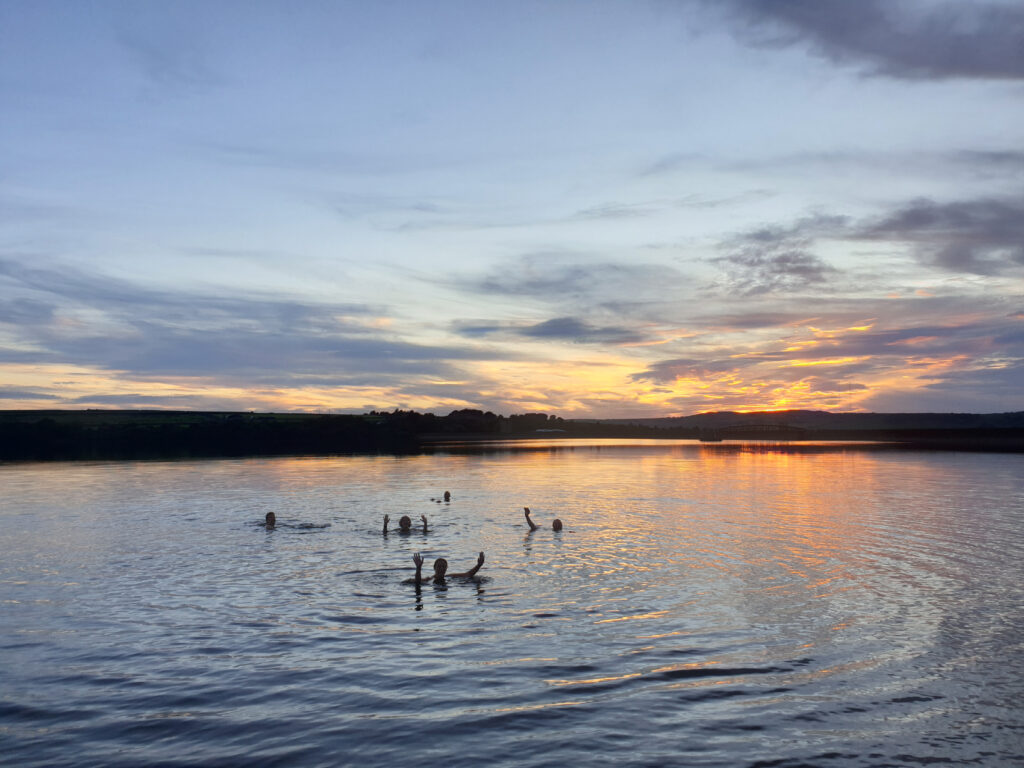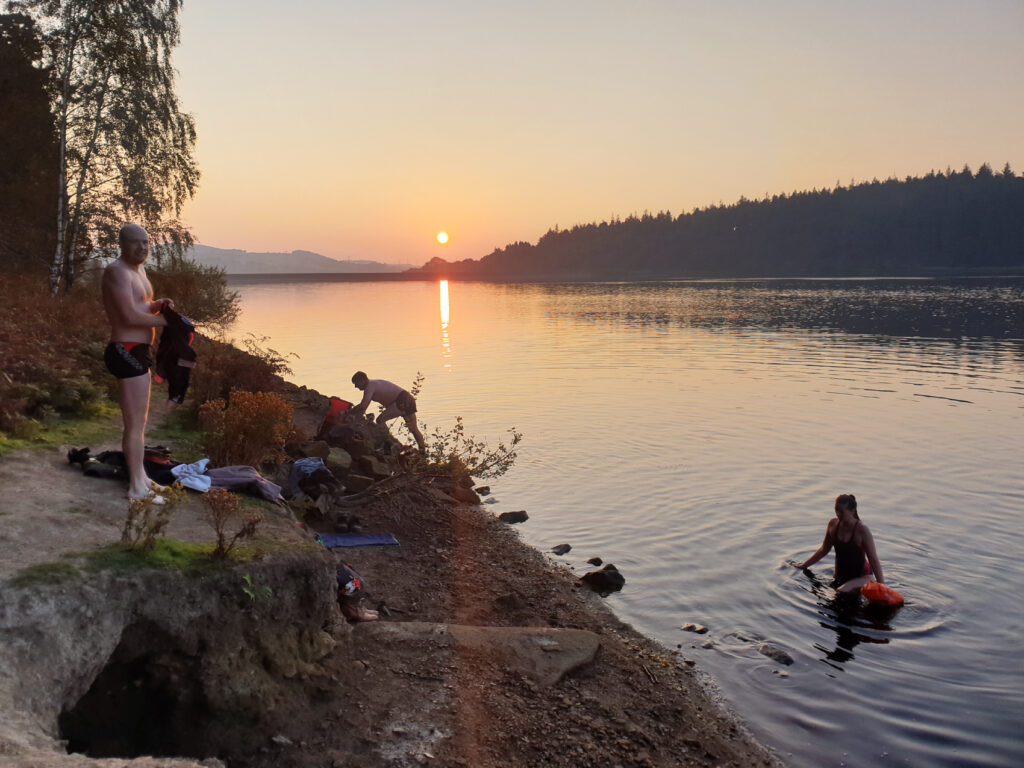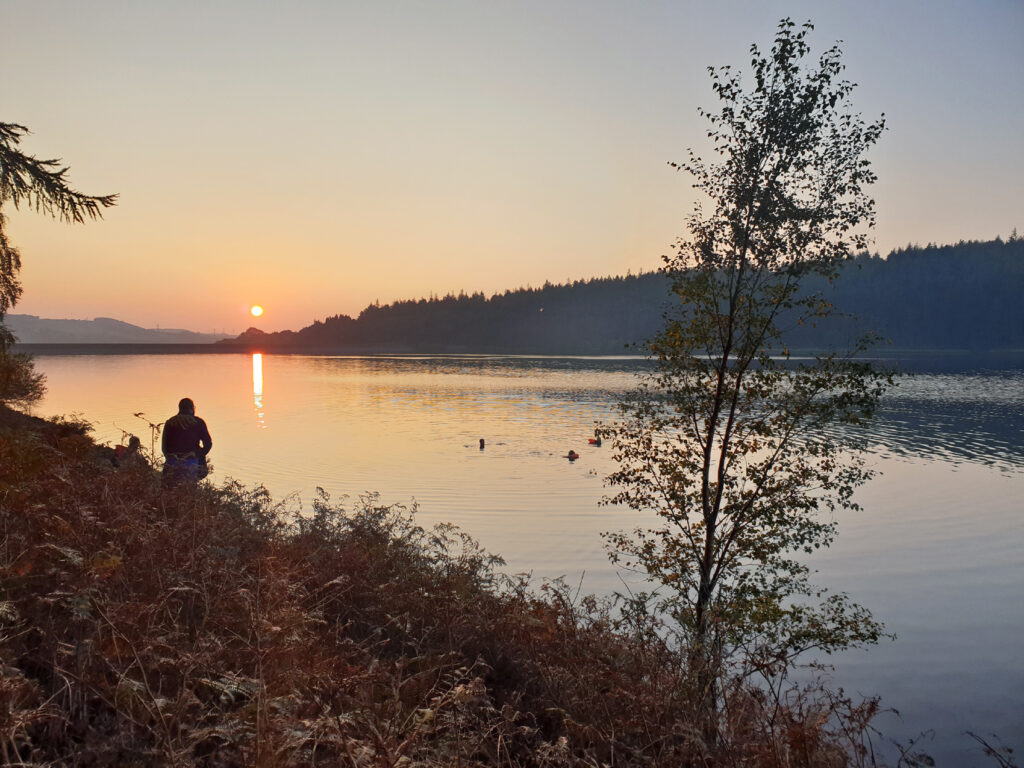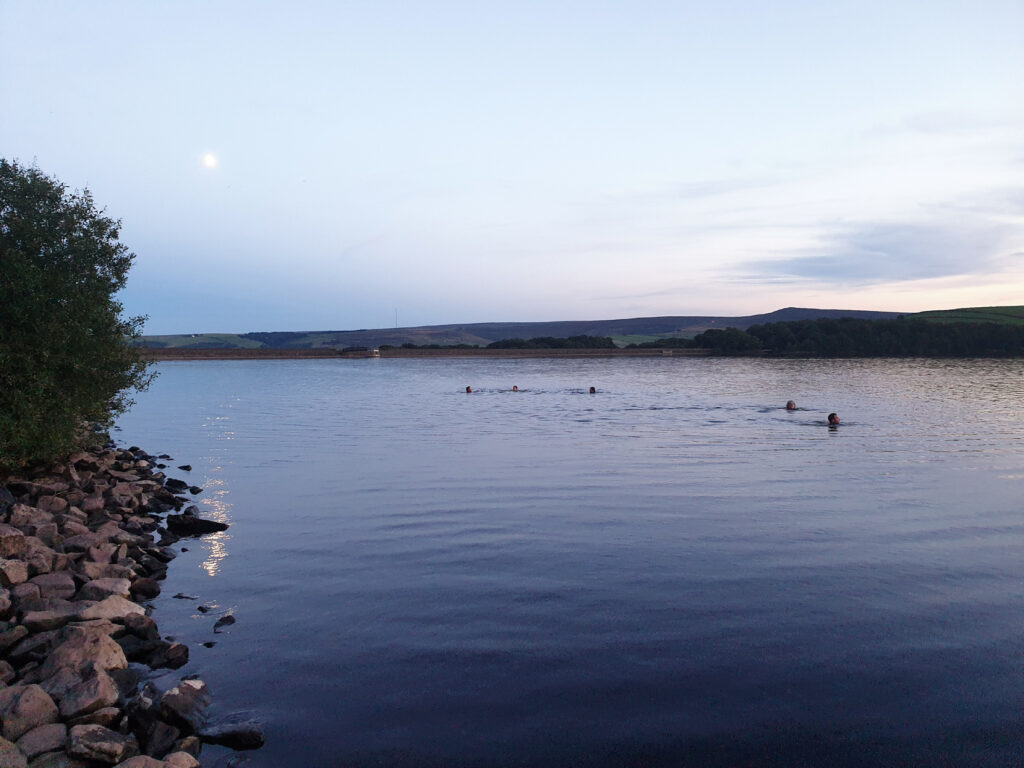We need places where we can swim, as more people want to take part in this activity that has so many positive benefits. Reservoirs could be the answer – and are likely to be more suitable than some small rural swimming hotspots that can seem overrun in a busy summer. One person who is bringing together people to swim and to campaign on this issue explains why we need why we need UK-wide swimming access in reservoirs.
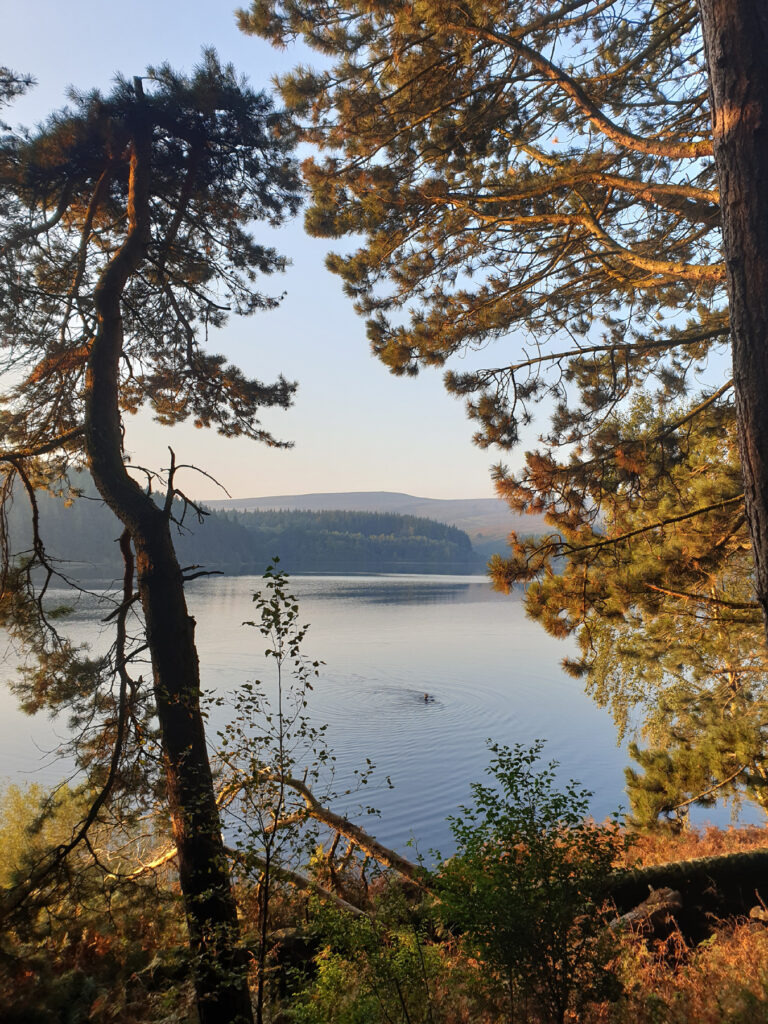 A similar version of this piece is on OSS website
A similar version of this piece is on OSS website
Owen is a swimming access campaigner, living and swimming in the middle of what was once known as “Sheffield Lakeland”, an area dominated by large majestic functioning reservoir lakes. He founded and admins SOUP – Sheffield OUtdoor Plungers, and is a member of the Outdoor Swimming Society campaigning and inland access team. Along with many others in the wider Yorkshire area and beyond, Owen is working to bring swimmers together, to collectively break down mental, social and structural barriers to free outdoor swimming. Instagram – @owainhaeman
All photos by Owen Hayman; they show swimmers at Langsett and Blackmoorfoot Reservoirs
Sixteen reasons why we need UK-wide swimming access in reservoirs
1. Scottish reservoirs have had free open swimming access since 2003
Pretty much all of Scotland’s 800 reservoirs have had free open access for swimming since 2003, when the Land Reform Act provided public access rights to most inland water. To Scottish people the idea of swimming in reservoirs is completely normal. Swimming in reservoirs is also perfectly legal and normal in many other European countries.
2. There are around 2000 reservoirs in England and Wales with huge potential to meet rising demand as swimming surges in popularity
Free informal outdoor swimming is seeing a huge and growing increase in popularity, and issues related to overuse and overcrowding of swim spots are becoming more common. By spreading swimmers across a larger number of spots, we can reduce the risk of small and sensitive spots being overused and damaged. As an example, the area encompassing Liverpool, Manchester, Leeds, Sheffield and Doncaster, has a population of around 7.6 million people, with more than 250 reservoirs, but a distinct lack of free open access swim spots.
3. Reservoirs have a huge potential to benefit public health
The health benefits of living near the coast or having access to places like the Lake District should not be limited to those who live near or can afford to access them, when there are so many underutilised ‘blue spaces’ near inland populations. Outdoor swimming is one of the few forms of exercise that is free, requires no special clothing or equipment, and is therefore accessible to people with low incomes. Swimming is also more open to some disabled people, than say, running or cycling. In some areas of the UK, reservoirs are far more accessible to the majority of the population than other water bodies suitable for swimming. Simply allowing swimming has very little cost. Many reservoirs already have the basic infrastructure for visitors, such as footpaths, bridleways and car parking. Reservoirs are a major untapped and much needed place for people to gain the health benefits of access to water and the two-way benefits of connecting people with the environment.
4. People who are there, care
People who enjoy and are connected to the outdoors are more likely to be defenders of it and to take action to help protect it. If people have no access to waterways such as reservoirs, the personal link to wider environmental issues cannot be made, and so pollution and degradation can go unnoticed. Our waterways need more people to engage with and care about them.
5. There are plenty of successful examples already
Some functioning reservoirs have free open swimming access (e.g. Sparth Reservoir, Huddersfield), or free lifeguarded bathing beaches with revenue raised from paid car parking (e.g. Rutland Water). There is also free open access for swimming at some disused reservoirs too (e.g. National Trust’s Carding Mill Valley Reservoir, Shropshire). Countless functioning reservoirs have formal open water swimming clubs on them (e.g. Harthill Reservoir, Rotherham).
6. Water companies have a responsibility to provide recreational access
The Water Industry Act 1991 Section 3 (5) https://www.legislation.gov.uk/ukpga/1991/56/section/3 states that water companies must “…ensure that the water or land is made available for recreational purposes and is so made available in the best manner.” While many reservoirs have footpaths, fishing and boating, swimming is generally neglected.
7. Landowner responsibility is widely misunderstood
Concern that the landowners and water companies are liable if swimmers are injured or drown is unsupported. Under civil case law and health and safety legislation, as long as they have done an assessment to see if there are any unusual risks that cannot be seen and as long as they have taken steps to mitigate or warn about these, they are not liable. Warning signs are required to highlight non-obvious hazards, but ‘No Swimming’ signs are generally not required. There is no landowner obligation to provide warnings of usual and obvious risks of swimming in water. Someone who chooses to enter the water willingly accepts the risks that are obvious and usual in undertaking this activity and cannot succeed in a claim against the landowner if they suffer injury as a result (see Landowner Liability and Swimmers, https://www.imogensriverswims.co.uk/blog/issues/landowner-liability-and-swimmers/. This is covered in our Access Guide – read about and download it on this website, https://www.outdoorswimmingsociety.com/access-all-areas/.
8. Reservoir swim safety is straightforward
The Scottish Outdoor Access Code https://www.outdooraccess-scotland.scot/scottish-outdoor-access-code gives simple and clear advice about safe swimming in reservoirs; “never go close to spillways or water intakes” (page 111).
Other than normal outdoor swim safety, Scottish advice (from Pentland Hills https://www.pentlandhills.org/safety/safety-reservoirs) is to:
– Access safely from a shallow area – do not enter by, or swim near, the reservoir structures, including the dam wall, towers or spillways. Tower sluices have undertows which can pull you under
– NEVER jump from the dam towers – people have died here by being sucked under by reservoir sluices,
Away from the tower, overflow and any other infrastructure, reservoirs are free from hazards associated with rivers and the sea. There is generally no perceivable flow, current or tides. Despite common misinformation that reservoirs are very cold, the upper depths in which people swim are no colder than in comparable natural lakes. At some times of year they are also warmer than rivers or the sea. When you take into account the risk associated with travelling long distances to the sea, the risks involved in swimming in a local reservoir are considerably lower.
9. Swimming is relatively safe
Over half of the people who drown at inland waters in the UK every year never intended to enter the water (as The National Fire Chiefs Council summary data https://www.nationalfirechiefs.org.uk/Be-Water-Aware ; and detailed data from The National Water Safety Forum
https://www.nationalwatersafety.org.uk/waid/annual-reports-and-data/ show), yet some water safety campaigns wrongfully suggest swimmers are most at risk. People choosing to swim, free from alcohol and not jumping in, make up a small fraction of UK drownings. Many reservoirs have fishing and boating on them, which carry a much higher accidental drowning rate than swimming (RoSPA analysis download https://www.rospa.com/rospaweb/docs/advice-services/leisure-safety/inland-waters-risk-assessment.pdf).
10. Some reservoir banks provide safe and sustainable water entry points
The large size and typically stone banks of many reservoirs make them capable of sustaining large numbers of swimmers, unlike more ecologically sensitive sites such as soft river banks, small ponds and plunge pools which can become damaged by large numbers of visitors. Many reservoirs have areas of bank with a gently sloping gradient and shallow water areas, ideal for gradual and safe access to and from the water. Away from any man-made steep sides and infrastructure, many reservoirs are no different to a natural lake.
11. Reservoirs have generally high water quality
Reservoirs are generally placed upstream of significant sources of pollution, and their catchments are managed to preserve high water quality. This makes them ideally suited for avoiding polluted water when swimming
12. Allowing swimming may make it safer
If helpful and accurate swim safety signage can be placed at reservoirs, people can make safer and better informed decisions. People inclined to take risks will always swim in reservoirs whether they are allowed to or not. They may be better informed if there is accurate signage, and a healthy safe swimming culture upheld by the presence of experienced swimmers, providing a good example.
13. A boost to the local economy
Opening up reservoirs for swimming can increase use of an area by tourists and locals, opening up economic opportunities in both rural and urban areas, through investment in campsites, hotels, cafes, equipment hire etc (the Lake District is a good example of this). Open water events often attract people to the area for a weekend, boosting the local economy.
14. Swimming is not a problem for drinking water
The idea that swimming in reservoirs pollutes drinking water ignores the huge advances in water treatment that have taken place since the industrial revolution. Water is not piped directly from open reservoirs to drinking water taps.
15. There is a long history of countryside access being gained through direct action
The 1932 Kinder Mass Trespass brought about the designation of Access Land, the Right to Roam and the National Parks. Forestry Commission Mountain Biking centres came about as a response to people illicitly mountain biking on Forestry Commission lands.
16. There is a growing public appetite for opening up water access
Sign the Clear Access Clear Waters campaign petition https://clearaccessclearwaters.org.uk/petition/
Join the Right to Roam campaign https://www.righttoroam.org.uk/
Prior to the Covid-19 pandemic it was announced that the heads of all major water companies will be asked to attend a meeting at Parliament with the All Party Parliamentary Group on Swimming, where MPs will demand that they do more to provide access for swimming in reservoirs, https://www.outdoorswimmingsociety.com/free-swimming-the-oss-goes-to-parliament/
Download the OSS Guide to establishing new inland bathing areas, go to the OSS website to read about and download the OSS Guide to Inland Bathing Areas (or this link downloads, https://www.outdoorswimmingsociety.com/wp-content/uploads/2018/11/Guide-To-Inland-Bathing-Areas-2018_small.pdf)
Join the Inland Access Group – Outdoor Swimming Society group on Facebook if you want to push for better access.
This piece is also on the OSS website, https://www.outdoorswimmingsociety.com/sixteen-reasons-reservoirs
And posted in the Outdoor Swimming Society Facebook group https://www.facebook.com/groups/outdoorswimmingsociety/permalink/10156731758772830
SOUPer Community – Sheffield OUtdoor Plungers https://www.facebook.com/groups/181406392266654/; @soup_sheffieldoutdoorplungers
Owen sums up the philosophy of the group:
“Almost everywhere we swim, there are ‘No Swimming’ signs. Many of the places we swim have almost no known history of swimming. This is an emerging wisdom. One of our core aims is to normalise outdoor free swimming in places where it was once a very eccentric thing to do, if not illegal. Not only do we aim to normalise swimming in the eyes of onlookers, but normalise it with ourselves too. We challenge the doubts within ourselves and aim to answer the questions we have as best we can. Through sharing maps and information, and inviting strangers to swim, break down social and personal barriers. We work towards a time when the invaluable benefits of swimming and dipping in open water are recognised and respected. Come for a swim! There may be cake too.”
Additional points from Imogen:
UPDATE: Yorkshire Water is talking to local swimmers and inland access reps about swimming in their reservoirs. Updates in the Inland Access Group. As part of these talks swimmers gave this presentation on why they should change their position and work with us, the Swimmers Perspective (Youtube, voiced over slides), https://m.youtube.com/watch?v=58AUQ-HAN0Y
WIDER RELEVANCE: I would add that most of these points would also apply to lakes and old gravel pits, which are widespread across East Anglia and the south of England, and probably other parts of the country as well. But these places also are surrounded by misunderstandings on safety and often by ‘No Swimming’ signs and attitudes. (I wrote about this in relation to clay lakes, https://www.imogensriverswims.co.uk/blog/swimming-in-clay-and-gravel-lakes/)
We all understand that access for swimming can be a tricky issue, especially when lots of people want to visit and swim in places that are in small rural communities, perhaps with limited infrastructure and small roads (and this year with concerns about coronavirus as well). Because there are so few places that we are ‘allowed’ to swim, and the numbers wanting to swim are high and have been growing, especially in recent years, those places can seem to those living locally to be overrun.
One solution is to look for places that would be more suitable, with manageable impact and lots of space. So it is frustrating to see swathes of lakes and suitable swimming places around the country, barred to us by these No Swimming attitudes.
Not everyone feels comfortable swimming at places with signs and prohibitions, as this piece by swimmer Suzie Wheway on why access and legality are problematic for swimmers illustrates, Breaking The Law To Swim, https://openwaterwheway.com/…/21/breaking-the-law-to-swim/
Let’s hope that these arguments for access can inspire us to campaign for access!

